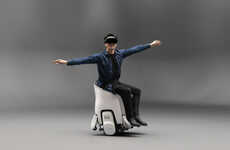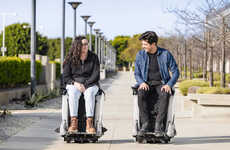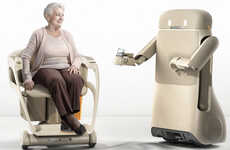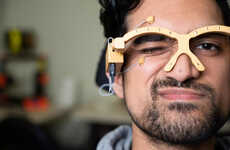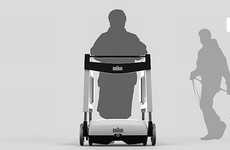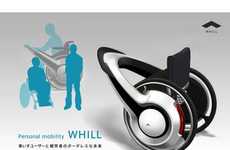
Elderly Patients are Granted Mobility with the Face-Controlled Wheelchair
Omar Yusuf — October 19, 2011 — Autos
Whether post-comatose atrophy or degenerative sclerosis has taken the strength from your muscles, the Face-Controlled Wheelchair will return the power of mobility to you and you'll be cruising down the main drag in no time.
It may be an early prototype, but the Face-Controlled Wheelchair made a string of impressive showings recently at Tokyo technology conferences. As long as the patient has muscle functionality above the neck, the device can be operated flawlessly. The Miyazaki University research team behind the project explains that turning the wheelchair is controlled by blinking and the user accelerates by clenching his or her teeth. Proximity sensors will automatically slam the brakes when a nearby object is detected, preventing amateurs from harming themselves. For the time being, the Face-Controlled Wheelchair implements a series of electrodes, though the researchers hope to replace them with wireless goggles.
It may be an early prototype, but the Face-Controlled Wheelchair made a string of impressive showings recently at Tokyo technology conferences. As long as the patient has muscle functionality above the neck, the device can be operated flawlessly. The Miyazaki University research team behind the project explains that turning the wheelchair is controlled by blinking and the user accelerates by clenching his or her teeth. Proximity sensors will automatically slam the brakes when a nearby object is detected, preventing amateurs from harming themselves. For the time being, the Face-Controlled Wheelchair implements a series of electrodes, though the researchers hope to replace them with wireless goggles.
Trend Themes
1. Face-controlled Wheelchair - Developing a wheelchair controlled by facial movements presents an opportunity for disruptive innovation in the mobility industry.
2. Muscle-operated Devices - Creating devices that can be operated using muscle functionality above the neck opens up possibilities for disruptive innovation in various industries.
3. Wireless Control Interfaces - Replacing electrodes with wireless goggles in control interfaces can lead to disruptive innovation in the assistive technology sector.
Industry Implications
1. Mobility - The development of the Face-Controlled Wheelchair can disrupt the mobility industry by providing a new and innovative solution for individuals with limited mobility.
2. Healthcare - Muscle-operated devices, such as the Face-Controlled Wheelchair, have the potential to transform the healthcare industry by improving mobility and independence for elderly or disabled patients.
3. Assistive Technology - The use of wireless control interfaces, like wireless goggles, in assistive devices can disrupt the assistive technology industry by creating more user-friendly and accessible solutions for individuals with disabilities.
1.1
Score
Popularity
Activity
Freshness


